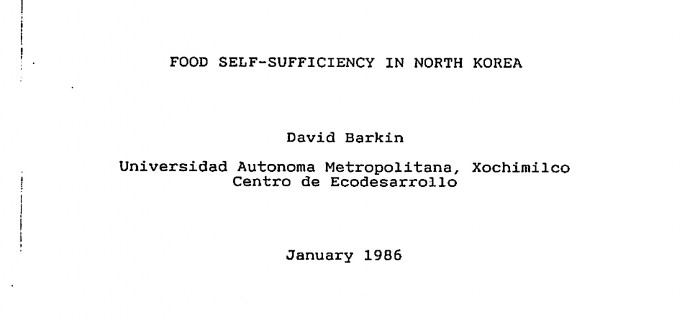Food Self-Sufficiency in North Korea
By David Barkin, January 1986, Research Report No. 4
Introduction
This paper outlines the history of North Korea’s attempts to achieve food self-sufficiency. After forty years of independence and thirty years of economic growth, the country has achieved this goal as part of a larger strategy of inwardly-based economic growth based on precepts of self-reliance. The North Koreans started to reorganize agriculture immediately after the 1953 Korean armistice to respond to the productive demands created by their policy of self-reliance.
They did not choose an extreme version of this approach (autarchy) which would have involved no trade with the outside world. Rather, they sought to produce those foods which could be efficiently produced given their climate, resource endowment, and socio-cultural requirements. Throughout the period since the end of the Korean War they have engaged in international trade in foodstuffs, but have never eased up on their commitment to maintain a balance or a surplus on their foreign account in food and to be able to feed themselves entirely from national supplies. It appears that they have been generally successful in this regard for the past decade.
An important lesson to be learned from the DPRK’s experience is that food self-sufficiency is probably attainable by many other countries.
The paper begins with an introduction to the historical situation in which the DPRK was founded and began its process of agricultural transformation. The agrarian reforms and initial productive structure are briefly described before reviewing the history of agricultural production and trade. The Koreans emphasize the importance of the three revolutions in the countryside—the ideological, cultural, and technical—as crucial in achieving the advances which are evident to any observer.
An analysis of the changes induced in these areas provides some basis for judging the relative roles of productive and political forces in the process of achieving self-sufficiency. Additional information on recent developments to improve productivity and raise output is reviewed. The scant evidence on consumption patterns available from local observation and FAO documents is also presented. Finally, an evaluation of the North Korean experience is essayed with a view to stimulating more discussion of the value of food selfsufficiency as a goal for other Third World countries.


 Help Food First to continue growing an informed, transformative, and flourishing food movement.
Help Food First to continue growing an informed, transformative, and flourishing food movement.




